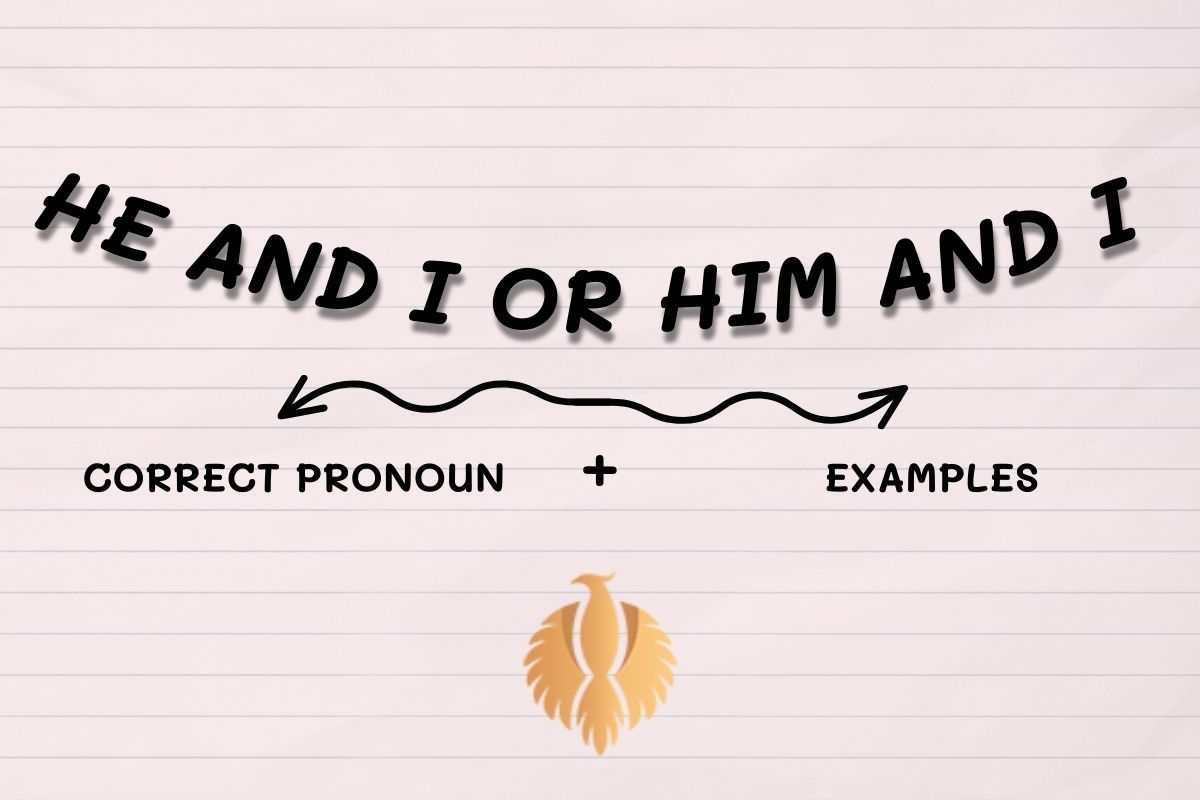In this article, I’m going to compare using He and I or Him and I to see which one is correct. “Him and I” is never correct in English.
So which one is correct? The subjective case “He and I” and the objective case “him and me” are the only possible grammatically correct combinations of the first person and third person singular pronouns: He and I are going to the library. She waved goodbye to him and me.
Pronouns play a crucial role in communication, allowing us to refer to people and things without continually repeating their names.
However, the correct usage of pronouns can sometimes be challenging, leading to confusion and errors.
One such dilemma arises when deciding between “he and I” and “him and I” as pronoun combinations.
In this essay, we will explore the grammatically correct usage of these pronouns and provide examples to clarify their appropriate contexts.
You might also enjoy: Paid Vs Payed : Differences + Examples [My 2024 Teaching Way]
Subjective Pronouns

Subjective pronouns are used when the pronoun acts as the subject of the sentence or clause. “He” and “I” are both subjective pronouns, but their usage differs depending on the context.
“He” is used when referring to someone who is the subject of a sentence or performing an action.
Similarly, “I” is used to represent oneself as the subject. For example, “He and I went to the park” is the correct form, as both “he” and “I” are the subjects of the sentence.
Subjective pronouns play a crucial role in language by serving as the subjects of sentences. They represent individuals or groups and enable smooth communication.
Subjective pronouns are versatile and include first-person, second-person, and third-person pronouns. Let’s explore each category in detail.
- First person
First-person subjective pronouns refer to the speaker or a group that includes the speaker. “I” is the singular form, while “we” is the plural form.
These pronouns allow individuals to express their thoughts, experiences, and opinions.
First-person pronouns enable personal connection and facilitate self-expression. For instance, “I love reading books” or “We are going to the park.”
- Second person
Second-person subjective pronouns address the listener or readers directly. “You” is the singular and plural form, making it unique among subjective pronouns.
It establishes a direct connection between the speaker and the audience, fostering effective communication.
Second-person pronouns can be found in instructions, advice, or conversations. For example, “You should try this recipe” or “You are doing a great job.”
- Third person
Third-person subjective pronouns refer to individuals or groups outside the conversation.
They include “he,” “she,” “it,” and “they.” “He” is used for males, “she” for females, “it” for inanimate objects or animals, and “they” for both singular and plural cases.
Third-person subjective pronouns enable us to discuss and describe others without repeating their names. For instance, “He is a talented musician” or “They are going to the movies.”
Subjective pronouns enhance the clarity and flow of conversations and written works.
They facilitate effective communication by allowing us to express ourselves, address others directly, and refer to individuals or groups.
Understanding and utilising subjective pronouns is essential for effective language use.
Therefore, subjective pronouns are indispensable in our daily communication. First-person pronouns enable self-expression and personal connection, second-
person pronouns establish direct communication with the audience, and third-person pronouns allow us to refer to individuals or groups outside the conversation.
Mastering the usage of subjective pronouns empowers us to express ourselves effectively and engage in meaningful conversations.
You might also enjoy: Month;s or Months; – Differences + Examples + Table [2024]
Objective Pronouns

Objective pronouns, on the other hand, are used when the pronoun acts as the object of a verb or preposition.
“Him” and “me” are examples of objective pronouns. “Him” is used to refer to someone who is the object of a verb or preposition, while “me” represents oneself as the object.
For instance, “The teacher praised him and me for our excellent work” is the appropriate usage as both “him” and “me” are the objects of the verb “praised.”
Now, I’m going to provide some examples of sentences that include objective pronouns:
- She gave him a gift.
- They invited us to the party.
- I saw her at the park.
- Please pass me the salt.
- He helped them with their homework.
- Can you lend me your pen?
- We are waiting for them.
- The teacher praised him for his hard work.
- I called her earlier today.
- The dog followed them home.
- Please remind me about the meeting.
- They offered us a job.
- I gave him a book to read.
- She asked them for directions.
- The doctor examined me thoroughly.
- They presented her with an award.
- The teacher assigned us a project.
- Please tell him to call me back.
- I saw them in the park yesterday.
- The waiter served us our meals.
- The manager promoted him to a higher position.
- Can you send her a message?
- They bought me a new phone.
- I gave them the keys to the car.
- She lent him her umbrella.
- We handed them the documents.
- Please give me a hand with this heavy box.
- They offered her a scholarship.
- The company hired him as a consultant.
- Can you help them with their luggage?
These sentences demonstrate the usage of objective pronouns, which are used as the objects of verbs or prepositions in a sentence. Objective pronouns include “him,” “her,” “us,” “them,” “me,” and “you.”
31 key points for He and I vs Him and I
- “He and I” is grammatically correct in formal writing.
- “Him and I” is considered informal or colloquial.
- “He and I” is used when referring to two people performing an action.
- “Him and I” is used when referring to two people receiving an action.
- “He and I” is preferred in academic and professional settings.
- “Him and I” is more commonly used in casual conversations.
- “Him and I” is often used in everyday speech.
- “He and I” is used when the pronouns are the subjects of a verb.
- “He and I” is used in sentences like “He and I went to the store.”
- “He and I” is grammatically correct according to traditional rules.
- “Him and I” may be considered incorrect by some grammar purists.
- “He and I” is used when the pronouns are the doers of the action.
- “Him and I” is used when the pronouns are the receivers of the action.
- “He and I” is more widely accepted in formal writing.
- “Him and I” is more commonly used in spoken language.
- “He and I” is considered more grammatically precise.
- “Him and I” is considered more colloquial.
- “Him and I” is used in sentences like “The teacher talked to him and I.”
- “He and I” is used when the pronouns are the subjects of a sentence.
- “Him and I” is used when the pronouns are the objects of a sentence.
- “He and I” is considered more grammatically accurate in standard English.
- “Him and I” is considered more relaxed in usage.
- “He and I” is used when the pronouns are the subjects of a clause.
- “Him and I” is used when the pronouns are the objects of a clause.
- “He and I” is considered the correct form in formal writing.
- “Him and I” is used in sentences like “The teacher talked to him and I after class.”
- “He and I” is considered more grammatically precise.
- “He and I” is used when the pronouns are the subjects of a verb phrase.
- “Him and I” is used when the pronouns are the objects of a verb phrase.
- “He and I” is considered more proper in formal writing.
- “Him and I” is considered more casual in speech.
Common Errors and Misconceptions
Understanding the correct usage of pronouns is essential for clear and effective communication. However, common errors and misconceptions often arise, particularly with the pronouns “he” and “him.”
These mistakes typically stem from a misunderstanding of the roles these pronouns play in sentences. Let’s delve deeper into these common errors and explore how to avoid them.
Subject vs. Object Pronouns
One of the most frequent mistakes is using “him” instead of “he” in subject positions. This error occurs because people sometimes confuse the roles of subject and object pronouns.
In English, “he” is a subject pronoun, while “him” is an object pronoun. The subject pronoun is used when the pronoun is the subject of the sentence, performing the action.
Conversely, the object pronoun is used when the pronoun is the object receiving the action.
For example, consider the sentence: “Him and I went to the park.” This is incorrect because “him” is an object pronoun, and it should not be used as the subject. The correct sentence is: “He and I went to the park.” Here, “he” is correctly used as the subject pronoun.
Object Pronoun Misuse
Similarly, another common error is using “he” instead of “him” in object positions. This mistake happens when people use the subject pronoun “he” where the object pronoun “him” is required.
For instance, in the sentence: “The teacher praised he and me,” the use of “he” is incorrect because it is in the object position. The correct sentence should be: “The teacher praised him and me.” In this case, “him” is the appropriate object pronoun.
You might also enjoy: Canceled or Cancelled: Grammar + Examples + Usage [2025]
Compound Subjects and Objects
These errors often become more pronounced in compound subjects and objects, where multiple pronouns or nouns are involved. For example, in the sentence: “Her and he are going to the store,” both pronouns are used incorrectly.
The correct sentence should be: “She and he are going to the store.” Here, “she” and “he” are both subject pronouns, correctly used in the subject position.
Similarly, in the sentence: “The manager spoke to he and I,” the pronouns are incorrectly used in the object position. The correct sentence is: “The manager spoke to him and me.” Here, “him” and “me” are object pronouns, correctly used in the object position.
Tips for Correct Usage
To avoid these common errors, it’s helpful to break down the sentence and identify the role each pronoun plays. Ask yourself whether the pronoun is performing the action (subject) or receiving the action (object).
This simple check can help ensure that you use the correct pronoun.
Another useful tip is to remove the other noun or pronoun in compound subjects or objects and see if the sentence still makes sense.
For example, in the sentence: “Him and I went to the park,” remove “and I” to see if “Him went to the park” makes sense. It doesn’t, which indicates that “him” is incorrect. Replacing it with “he” makes the sentence correct: “He went to the park.”
In summary, understanding the difference between subject and object pronouns is crucial for proper grammar.
Common errors such as using “him” instead of “he” in subject positions, and “he” instead of “him” in object positions, can be avoided by recognizing the roles these pronouns play in sentences.
By practicing these distinctions and applying simple checks, you can improve your grammar and communicate more effectively.
You might also enjoy: Openned or Opened: Spelling + Examples [2024]
Contextual Understanding

To determine which pronoun combination to use, it is essential to understand the context and the role of the pronouns in the sentence.
If the pronouns are the subjects of the sentence or clause, “he and I” should be used. Conversely, if the pronouns are the objects of a verb or preposition, “him and me” is the correct choice.
Understanding the grammatical function of the pronouns in the sentence aids in selecting the appropriate pronoun combination.
Examples:
To further illustrate the correct usage of these pronoun combinations, let’s consider a few examples:
1. Subjective Pronoun
– Correct: “He and I are going to the movies.”
– Incorrect: “Him and I are going to the movies.”
2. Objective Pronoun
– Correct: “The teacher called him and me to the front.”
– Incorrect: “The teacher called he and me to the front.”
3. Mixed Subjective and Objective Pronouns
– Correct: “She invited him and me to her party.”
– Incorrect: “She invited he and me to her party.”
Choosing the correct pronoun combination “he and I” or “him and me” is essential for clear and effective communication.
By understanding the grammatical roles of these pronouns, we can avoid common errors and misconceptions.
“He” and “I” are subjective pronouns used as the subjects of a sentence, while “him” and “me” are objective pronouns used as objects.
By considering the context and function of the pronouns, we can confidently choose the appropriate pronoun combination and enhance our language skills.
The confusion between “he and I” and “him and me” often arises due to a lack of understanding of the different functions of subjective and objective pronouns.
Subjective pronouns, such as “he” and “I,” are used when the pronoun is the subject of the sentence or clause.
They are the ones performing the action or carrying out the verb. On the other hand, objective pronouns, like “him” and “me,” are used when the pronoun is the object of a verb or preposition, receiving the action rather than performing it.
To determine which pronoun combination to use, it is helpful to break down the sentence and identify the subject and object. Let’s consider a few more examples to clarify the distinction:
– Correct: “He and I are going to the park.”
– Incorrect: “Him and me are going to the park.”
In this example, “he” and “I” are the subjects of the sentence, indicating that they are the ones performing the action of going to the park. Therefore, “he and I” is the correct form.
– Correct: “The teacher praised him and me for our hard work.”
– Incorrect: “The teacher praised he and me for our hard work.”
In this instance, “him” and “me” are the objects of the verb “praised.” They are the ones receiving the action of being praised, rather than performing the action. Hence, “him and me” is the appropriate choice.
– Correct: “She invited him and me to her house.”
– Incorrect: “She invited he and me to her house.”
In this example, “him” and “me” function as the objects of the verb “invited.” They are the ones being invited, while the subject of the sentence remains “she.” Therefore, “him and me” is the correct pronoun combination.
Understanding the distinction between subjective and objective pronouns is crucial for using proper grammar and conveying precise meaning in our sentences.
By considering the role of the pronouns in relation to the verb and sentence structure, we can select the appropriate pronoun combination and avoid common errors.
You might also enjoy: How Are You Fairing or Faring? Differences + Examples
Here are 30 sentences using “he and I” correctly

- He and I went to the park yesterday.
- He and I are good friends.
- He and I enjoy playing basketball together.
- He and I share the same birthday.
- He and I are planning a trip to Europe.
- He and I attended the same university.
- He and I work in the same office.
- He and I are in the same book club.
- He and I love going to the movies.
- He and I volunteer at the local shelter.
- He and I often go hiking on weekends.
- He and I have known each other since childhood.
- He and I are neighbours.
- He and I are both passionate about photography.
- He and I are members of the same gym.
- He and I enjoy cooking together.
- He and I are planning to start a business.
- He and I often go fishing together.
- He and I are part of a music band.
- He and I are teammates on the soccer team.
- He and I are studying for the same exam.
- He and I are going to the concert tonight.
- He and I have similar tastes in music.
- He and I are participating in a charity run.
- He and I are working on a project together.
- He and I are attending a wedding next week.
- He and I are both interested in astronomy.
- He and I are going to the beach this weekend.
- He and I are planning to write a book together.
- He and I are part of a community theatre group.
- When determining whether to use “He and I” or “Him and I” in a sentence, it is important to understand the role of each pronoun in the sentence.
- “He” is a subject pronoun, used when the pronoun is the subject of the sentence or clause. “I” is also a subject pronoun, used in the same way. Therefore, when referring to two individuals as subjects in a sentence, “He and I” would be the correct choice.
- On the other hand, “Him” is an object pronoun, used when the pronoun is the object of a verb or preposition. “I” remains a subject pronoun. Therefore, when referring to one individual as the object and one individual as the subject in a sentence, “Him and I” would be the correct choice.
- In summary, use “He and I” when both pronouns are the subjects of the sentence, and use “Him and I” when one pronoun is the object and the other is the subject.
Frequently Asked Questions
- What is the difference between “He and I” and “Him and I”?
“He and I” is used when both pronouns are the subjects of the sentence, while “Him and I” is used when one pronoun is the object and the other is the subject.
- In what context would you use “He and I”?
You would use “He and I” when referring to both individuals as the subjects of the sentence.
- When should I avoid using “Him and I”?
Avoid using “Him and I” when both pronouns are intended to be subjects in the sentence.
- Can you provide a simple rule to remember when to use “He and I” or “Him and I”?
Remember that “He and I” are subjects, while “Him and I” involve one subject and one object.
Conclusion
Therefore, the correct usage of pronouns is paramount for effective communication. The choice between “he and I” and “him and me” depends on whether the pronouns are serving as subjects or objects in the sentence.
This distinction is crucial for conveying our thoughts clearly and accurately, ensuring that our messages are understood as intended.
Subjective Pronouns
Subjective pronouns, such as “he” and “I,” function as subjects in a sentence. They perform the action and are the focus of the sentence. For example, in the sentence “He and I went to the store,” “he” and “I” are the subjects who are performing the action of going to the store.
Using the correct subjective pronouns helps to clarify who is taking the action, making the sentence clear and precise.
Objective Pronouns
On the other hand, objective pronouns, like “him” and “me,” act as objects in a sentence. They receive the action and are not the primary focus. For instance, in the sentence “The teacher praised him and me,” “him” and “me” are the objects receiving the teacher’s praise.
Using the correct objective pronouns ensures that the sentence accurately reflects who is receiving the action, maintaining clarity and coherence.
Understanding Grammatical Roles
A comprehensive understanding of the grammatical functions of these pronouns enables us to choose the appropriate pronoun combinations with confidence, thereby articulating our ideas accurately.
This comprehension entails identifying whether the pronouns are acting as the subject, performing the action, or as the object, receiving the action. Such a distinction is essential for forming grammatically correct sentences and preventing frequent mistakes.
Common Mistakes and How to Avoid Them
A frequent error involves the use of “him” in place of “he” when the pronoun is in the subject position. This mistake typically arises from a misunderstanding of the functions of pronouns within a sentence.
For instance, the phrase “Him and I went to the park” is incorrect; the proper usage would be “he and I.” Likewise, substituting “he” for “him” in the object position constitutes another common error. An example of this is the statement “The teacher praised he and me,” which should correctly be phrased as “him and me.”
To prevent these errors, it is beneficial to analyze the sentence and determine the function of each pronoun.
Consider whether the pronoun is acting as the subject (performing the action) or as the object (receiving the action). This straightforward assessment can assist in ensuring the appropriate pronoun is utilized.
The Importance of Clear Communication
Effective communication is essential in both written and spoken forms. The skilled application of pronouns greatly enhances our language proficiency and promotes clarity in expression.
By employing pronouns accurately, we are able to articulate our messages with greater clarity, thereby minimizing the potential for misunderstandings. This level of clarity is particularly vital in professional and academic environments, where accurate communication is of utmost importance.
Practical Application
To reinforce this understanding, practice using these pronouns in different sentences. Create scenarios where you can apply “he and I” and “him and me” appropriately.
For example, write sentences like “He and I are going to the meeting” and “The manager spoke to him and me.” This practice will help you internalize the correct usage and make it second nature.
The correct usage of pronouns is essential for effective communication. By understanding the roles of subjective and objective pronouns, we can confidently choose the right pronoun combinations and express our thoughts accurately.
This understanding not only enhances our language skills but also ensures that our communication is clear and effective. Keep practicing, and soon using the correct pronouns will become an effortless part of your language use.
Clear and precise communication is a valuable skill, and mastering pronoun usage is a significant step towards achieving it.

Hi, welcome to my blog! My name is Omid and I am thrilled to have you here! I am an English language teacher with 12 years of experience and hold multiple international certifications (TESOL, IELTS, TOEFL, PTE, CELTA). Additionally, I hold a PhD in Applied Linguistics with a specialization in Teaching English as a Second Language (TESL), which fuels my passion for teaching English and assisting others in mastering the language. To me, nothing is more rewarding than helping individuals enhance their English language abilities through various methods. So, let’s embark on this journey of learning English together.




